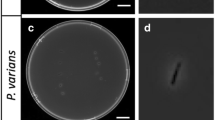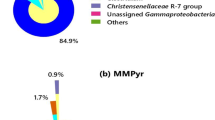Abstract
Arylsulfatase activity and arylsulfatase-producing bacteria were estimated in sediment samples collected from 3 different biotopes: marine, estuarine, and mangrove. No direct relationship could be established between activity and the number of bacteria at any station. In general, clayey sediments always harboured more arylsulfatase producers than sandy sediments, irrespective of salinity variations. Of the 3 biotopes investigated, the mangrove area exhibited maximum activity. The enzyme showed two pH optima, one at 6.2, the other at 9.0. The optimum substrate concentration was 12x10-4M. Higher substrate concentrations tended to inhibit arylsulfatase activity. The recovery of added phenolphthalein was maximum only at pH 6.2; KCN, Na2So4, and KH2Po4 inhibited enzyme activity by 65.5, 46.8 and 37.5%, respectively. More than one type of arylsulfatase may be present in marine sediments; further studies on the role of arylsulfatases are required, since arylsulfatases have been reported to bear on the formation and hardening of exoskeletons in marine forms.
Similar content being viewed by others
Literature Cited
Abbott, L.D.: Phenolsulfatase activity. Archs Biochem. 15, 205–214 (1947)
Ayyakkannu, K. and D. Chandramohan: Occurrence and distribution of phosphate solubilizing bacteria and phosphatase in marine sediments at Porto Novo. Mar. Biol. 11, 201–205 (1971)
Dodgson, K.S. and B. Spencer: The anomalous kinetics of arylsulfatase A of human tissues. Biochem. J. 62, p. 30 (1956)
— Assay of sulfatases. In: Methods of biochemical analysis, Vol. 4. pp 211–256. Ed. by D. Glick. New York: Interscience Publishers 1957
—, J.I.M. Lewis and B. Spencer: Studies on sulfatases. 3. The arylsulfatase and B-glucuronidase of marine molluscs. Biochem. J. 55, 253–259 (1953)
—, T.H. Melville, B. Spencer and K. Williams: Studies on sulfatases. 8. The arylsulfatase of a strain of Alcaligenes metalcaligenes isolated from intertidal mud. Biochem. J. 58, 182–187 (1954)
Harada, T. and B. Spencer: The effect of sulfate assimilation on the induction of arylsulfatase synthesis in fungi. Biochem. J. 82, 148–156 (1962)
Neuberg, C. and K. Kurono: Sulfatases I. The enzymic fission of benzene sulfonic acid. Biochem. Z. 140, 295–298 (1923)
Shimony, T. and R.F. Nigrelli: Studies on arylsulfatases in the barnacle Balanus eburneus. Mar. Biol. 14, 349–358 (1972)
Skujins, J.: Enzymes in soil. In: Soil biochemistry, pp 371–414. Ed. by A.D. McLaren and G.H. Peterson. New York: Marcel Dekker 1967
Whitehead, J.E.M., A.R. Morrison and L. Young: Bacterial arylsulfatase. Biochem. J. 51, 585–594 (1952)
Author information
Authors and Affiliations
Additional information
Communicated by N.K. Panikkar, New Delhi
Rights and permissions
About this article
Cite this article
Chandramohan, D., Devendran, K. & Natarajan, R. Arylsulfatase activity in marine sediments. Mar. Biol. 27, 89–92 (1974). https://doi.org/10.1007/BF00394764
Accepted:
Issue Date:
DOI: https://doi.org/10.1007/BF00394764




